#Backend Html Admin Template
Explore tagged Tumblr posts
Text
How to Create Dynamic Forms in Angular
Creating forms is a common task in web development, and Angular provides powerful tools to make this process easier and more flexible. One advanced feature is the ability to build dynamic forms, which are forms that can change based on data or user actions. If you’re looking to master Angular and build such smart form systems, enrolling at the Best Angular Training Institute in Hyderabad, Kukatpally, KPHB can help you gain the right skills and practical knowledge.
What Are Dynamic Forms?
Dynamic forms are forms that are not hard-coded in the template but are created and adjusted at runtime. This means the structure of the form — the number of fields, types of inputs, and even validations — can change depending on the situation. For example, if you're building a form where the user selects a category, and based on that selection different input fields appear, you are working with a dynamic form.
Why Use Dynamic Forms?
Dynamic forms offer several benefits:
Flexibility: They allow your application to respond to user choices and backend data in real time.
Scalability: Instead of creating multiple templates for different forms, a single dynamic form can handle multiple use cases.
Efficiency: They reduce code duplication and allow you to reuse form logic across different sections of your application.
Real-World Use Cases
Dynamic forms are especially useful in applications such as:
Surveys and Quizzes: Where each question and its options are fetched from a database.
E-commerce Platforms: Where different product categories require different sets of input fields.
Custom Form Builders: That let users define their own fields and input types.
Admin Dashboards: Where settings or preferences may vary by role or department.
How Does Angular Support Dynamic Forms?
Angular provides a form system that is well-suited for dynamic behavior. With features that allow form controls to be created and managed using logic written in the component, Angular makes it possible to build forms that are generated and modified entirely based on data.
Developers can also apply validations, control visibility, and handle user input seamlessly using Angular’s form handling features.
Key Concepts Behind the Scenes
Although we’re not going into technical details or code here, it’s useful to understand the key parts:
Form Groups are used to group related fields.
Form Arrays allow multiple similar fields to be added dynamically (like a list of addresses or phone numbers).
Validation Rules can be applied to ensure users enter correct data, even for fields that appear dynamically.
By managing these structures programmatically, developers can adjust the form layout and behavior as needed without writing static HTML for every scenario.
Conclusion
Dynamic forms in Angular are a powerful feature for building flexible, responsive, and intelligent user interfaces. They help reduce repetitive code and make your application more adaptable to user and data needs. If you want to become confident in working with such advanced Angular features, consider joining Monopoly IT Solutions — a trusted institute that provides in-depth, hands-on training tailored for today’s web development needs.
#best angular training in Hyderabad#best angular training in Kukatpally#best angulat training in KPHB#web-development-angular-training
0 notes
Text
The Ultimate Guide to Hiring Django Developers in 2025
If you’re building a scalable, secure, and high-performing web application in 2025, Django remains one of the best frameworks to use. But to unlock its full potential, you need to hire Django developers who understand how to use this Python-based framework to meet your business goals.

Why Choose Django in 2025?
Django is still a top choice for web development in 2025 due to:
Rapid Development: Built-in admin panel, ORM, and modular architecture
Scalability: Used by companies like Instagram, Spotify, and NASA
Security: Protection against XSS, CSRF, and SQL injections
Community Support: A mature and well-documented ecosystem
When Should You Hire a Django Developer?
You should hire Django developers if:
You need to build a custom web application or CMS
You’re planning a secure eCommerce site
You require API development for mobile/web apps
You want a high-performance MVP or startup product
You need a secure backend for SaaS or enterprise software
Key Skills to Look For
Before hiring, make sure the Django developer is skilled in:
Python programming
Django framework (ORM, views, forms, templates)
REST APIs (DRF — Django REST Framework)
Front-end integration (HTML, CSS, JavaScript, React/Angular)
Database systems (PostgreSQL, MySQL, SQLite)
Version control (Git)
Deployment (Docker, AWS, CI/CD)
Hiring Options: Freelancer vs Agency
Option Pros ConsFreelancer Cost-effective, flexible Limited availability, may lack team supportAgency (like Oodles)Scalable, full-stack team, support & QASlightly higher cost
If you want a full-cycle development solution with guaranteed timelines and post-launch support, hiring through an agency is ideal.
Interview Questions to Ask
Here are a few practical questions you can ask during the interview:
What’s the difference between a Django model and a Django form?
How would you handle user authentication in Django?
Explain the role of middleware in Django.
What are signals in Django and when should you use them?
How do you optimize Django for performance?
How Much Does It Cost to Hire Django Developers in 2025?
Freelancers: $20 — $60/hour (based on location & experience)
Agencies: $25 — $100/hour (comes with project managers, QA, and design support)
Dedicated Developer (Full-Time): $2000 — $6000/month
Outsourcing to countries like India gives you access to highly skilled developers at lower cost without compromising quality.
Where to Find Django Developers?
Freelance Platforms: Upwork, Freelancer, Toptal
Developer Marketplaces: Turing, Arc, Gun.io
Agencies: Oodles — Hire Django Developer
Job Boards: StackOverflow, GitHub Jobs, Remote OK
✅ Final Thoughts
Hire Django developers in 2025 is about more than just technical skills. You need someone who understands your business vision, works well with your team, and builds secure, scalable web applications with future growth in mind.
Whether you’re launching a new product, upgrading your tech stack, or expanding your backend, make sure you hire a Django developer who brings value from day one.
Looking to hire Django experts? Partner with Oodles for experienced Django developers who deliver quality, speed, and security.
0 notes
Text
What is Django for beginners.
What is Django for Beginners?
Django is a high-level web framework for Python that encourages rapid development and clean, pragmatic design. It was created to help developers build web applications quickly and efficiently, allowing them to focus on writing code rather than dealing with the complexities of web development. For beginners, Django offers a powerful yet accessible way to learn the fundamentals of web development while building real-world applications.
Understanding Django
At its core, Django is designed to simplify the process of building web applications. It follows the Model-View-Template (MVT) architectural pattern, which separates the application into three interconnected components:
Model: This component handles the data and business logic. It defines the structure of the data, including the fields and behaviors of the data you’re storing. In Django, models are defined as Python classes, and they interact with the database to create, read, update, and delete records.
View: The view is responsible for processing user requests and returning the appropriate response. It acts as a bridge between the model and the template, retrieving data from the model and passing it to the template for rendering.
Template: Templates are used to define the presentation layer of the application. They are HTML files that can include dynamic content generated by the view. Django’s templating engine allows you to create reusable components and maintain a clean separation between the presentation and business logic.
Key Features of Django
Django comes with a plethora of features that make it an excellent choice for beginners:
Batteries Included: Django is often described as a "batteries-included" framework because it comes with a wide range of built-in features. This includes an admin panel, user authentication, form handling, and security features, which means you can get started quickly without needing to install additional packages.
Robust Security: Security is a top priority in Django. The framework provides built-in protections against common web vulnerabilities such as SQL injection, cross-site scripting (XSS), and cross-site request forgery (CSRF). This allows beginners to focus on building their applications without worrying about security issues.
Scalability: Django is designed to handle high-traffic applications. Its architecture allows for easy scaling, making it suitable for both small projects and large-scale applications. As your application grows, Django can accommodate increased traffic and data without significant changes to the codebase.
Versatile Database Support: Django supports multiple database backends, including SQLite, PostgreSQL, MySQL, and Oracle. This flexibility allows beginners to choose the database that best fits their needs and easily switch between them if necessary.
Strong Community and Documentation: Django has a large and active community, which means there are plenty of resources available for beginners. The official documentation is comprehensive and well-structured, making it easy to find information and learn how to use the framework effectively.
Benefits of Using Django for Beginners
Ease of Learning: Django’s clear and consistent design makes it easy for beginners to grasp the concepts of web development. The framework’s use of Python, a language known for its readability and simplicity, further lowers the barrier to entry.
Rapid Development: With Django, you can quickly build and deploy web applications. The framework’s built-in features and tools streamline the development process, allowing you to focus on writing code rather than dealing with repetitive tasks.
Community Support: As a beginner, having access to a supportive community can be invaluable. Django’s community is welcoming and offers numerous tutorials, forums, and resources to help you learn and troubleshoot issues.
Portfolio Development: Learning Django allows you to build real-world applications that you can showcase in your portfolio. This is particularly beneficial if you’re looking to enter the job market as a web developer, as having practical experience can set you apart from other candidates.
Long-Term Viability: Django is a mature framework that has been around since 2005. It is actively maintained and updated, ensuring that it remains relevant in the ever-evolving landscape of web development. By learning Django, you are investing in a skill that will be valuable for years to come.
Getting Started with Django
If you’re a beginner looking to dive into Django, here’s a simple roadmap to get you started:
Install Python: Since Django is a Python framework, the first step is to ensure you have Python installed on your machine. You can download it from the official Python website.
Set Up a Virtual Environment: It’s a good practice to create a virtual environment for your Django projects. This keeps your project dependencies isolated from other projects. You can use tools like venv or virtualenv to create a virtual environment.
Install Django: Once your virtual environment is set up, you can install Django using pip, Python’s package manager. Run the command pip install django in your terminal to get started.
Create a New Project: Use Django’s command-line tool to create a new project. Run django-admin startproject projectname to generate the necessary files and directory structure.
Run the Development Server: Navigate to your project directory and run the command python manage.py runserver. This will start a local development server, allowing you to view your application in your web browser.
Build Your First App: Django encourages a modular approach to development. You can create individual applications within your project using the command python manage.py startapp appname. From there, you can define models, views, and templates to build your application.
Explore Tutorials and Resources: Take advantage of the wealth of tutorials, documentation, and online courses available for Django. Websites like Django’s official documentation, YouTube, and platforms like Udemy and Coursera offer valuable learning materials.
Conclusion
In summary, Django is an excellent choice for beginners looking to learn web development. Its powerful features, robust security, and supportive community make it an ideal framework for building web applications. By understanding the fundamentals of Django and following a structured learning path, you can quickly gain the skills needed to create dynamic, data-driven websites. Whether you’re looking to build a personal project, enhance your portfolio, or start a career in web development, Django provides the tools and resources to help you succeed.
0 notes
Text
TYPO3 Programming Made Simple: Your First Step

If you’re looking to build powerful, flexible websites, TYPO3 CMS is a great place to start. It’s an open-source content management system (CMS) built for serious projects—think multilingual corporate sites, secure web platforms, and custom features that go far beyond a simple blog. This guide will walk you through the basics of TYPO3 programming, so you can start your development journey with confidence.
What is TYPO3 CMS?
TYPO3 is a CMS written in PHP that’s designed for high-performance websites. Unlike basic CMS tools, TYPO3 is built for large-scale projects. It gives you control over how your website works and looks, using tools like TypoScript, Fluid templates, and extensions.
Getting Your TYPO3 Development Environment Ready
Before you start coding, you need to prepare your setup. Don’t worry—it’s pretty straightforward.
System Requirements: Make sure your system has PHP 8.x, MySQL or MariaDB, Apache or Nginx, and Composer installed.
Install TYPO3 with Composer: Open your terminal and run: bashCopyEditcomposer create-project typo3/cms-base-distribution my-project
Set Up the Database: Once TYPO3 is installed, visit your project in a browser. The built-in installer will guide you through setting up the database and finishing the configuration.
TYPO3 Programming Basics
Let’s look at the key tools TYPO3 gives you to build your site.
TypoScript
TypoScript is TYPO3’s configuration language. It tells TYPO3 how to render content on the page. You don’t need to write PHP—TypoScript lets you control layout and behavior using simple rules.
Fluid Templates
Fluid is TYPO3’s templating engine. It helps separate your HTML design from the backend logic, so you can focus on layout while keeping your code clean and maintainable. It’s especially useful if you're working with designers or frontend developers.
Extensions
In TYPO3, almost everything is built as an extension. Need a blog? An online store? A custom form? There’s probably an extension for that. You can install ready-made ones from the TYPO3 Extension Repository—or build your own for full control.
How to Build Custom Features
Here’s how developers add advanced features to TYPO3:
Creating Extensions: You can use the Extension Builder tool or create one manually by setting up controllers, models, and views. TYPO3 uses the MVC (Model-View-Controller) pattern, which keeps your code structured and easy to work with.
Custom Content Elements: Want content blocks tailored to your exact needs? Use a tool like Mask or write your own to create reusable, flexible elements for editors.
Backend Modules: TYPO3 lets you build tools inside the admin area—like custom dashboards or management panels—to improve the editing experience.
Debugging and Best Practices
No project runs perfectly all the time. Here’s how to handle issues the TYPO3 way:
Turn on debugging in the LocalConfiguration.php file or the Admin Panel.
Use TYPO3’s built-in logging and error reporting to catch problems early.
Follow TYPO3’s coding standards to keep your project clean, consistent, and easy to maintain—especially if you're working in a team.
Why TYPO3?
Built to Scale: TYPO3 handles huge websites with thousands of pages and users.
Multilingual Ready: It makes managing content in multiple languages straightforward and efficient.
Secure by Design: TYPO3 includes strong access controls and gets regular security updates.
Helpful Community: With detailed documentation, active forums, and tutorials, help is always within reach.
Final Thoughts
TYPO3 isn’t just another CMS—it’s a developer’s toolset for building professional, scalable websites. Once you understand TypoScript, Fluid templates, and extensions, you’ll be ready to create just about anything. Whether it’s a small custom feature or a full-blown enterprise website, TYPO3 gives you the structure and power to bring your ideas to life.
0 notes
Text
Simplifying Shopify Development: Key Insights To Know
Shopify is a powerful eCommerce platform—but that doesn’t mean development on it is always simple. Whether you're building a custom storefront, editing a theme, or integrating third-party apps, things can get messy fast. But with the right approach, you can cut through the noise and build clean, functional Shopify experiences without pulling your hair out.
Here are the key insights every business should keep in mind when working with Shopify Developers.

1. Understand the Stack You’re Working With
Shopify isn’t just Liquid templates and some settings. It’s a mix of:
Liquid: Shopify’s templating language
HTML/CSS/JavaScript: For UI and interaction
Shopify APIs: Admin, Storefront, and more
GraphQL & REST: Used for querying data
App Bridge & Polaris: For building embedded apps
Know which parts you actually need before you start. For example, if you're just customizing a theme, you might never touch the API. But if you're building a headless storefront or a backend integration, the API is where you'll live.
2. Use Shopify CLI—It Saves Time
The Shopify CLI is your best friend. It:
Creates new themes or apps
Lets you preview changes locally
Connects to your store with minimal setup
Pushes code changes with a single command
It’s basically the difference between hammering nails by hand and using a nail gun. Learn it, use it.
3. Stick to Sections and Blocks for Themes
Shopify’s Online Store 2.0 update made themes way more modular and flexible. The key components:
Sections: Reusable layout components
Blocks: Modular content inside sections
Build your theme like Lego. Avoid stuffing logic into a single template. Use JSON templates and dynamic sections to make customization easier for merchants and future you.
4. Don’t Overcomplicate App Development
Thinking of building an app? Start with the question: Does this really need to be an app?
If it does, start small. Shopify apps don’t need to be huge or complicated. In fact, many successful apps do one thing well—automate a task, sync data, or add one new customer-facing feature.
Start with:
A clear problem your app solves
A simple admin UI (Polaris helps here)
Clean API integration (use GraphQL where possible—it’s faster and more flexible than REST)
And remember: hosting, scaling, and securing your app are your job. Use a modern backend framework like Node.js with Express or Ruby on Rails, and keep your architecture simple.
5. Master Shopify’s API Rate Limits
Shopify limits how many API requests you can make. If you’re pulling lots of data or running background jobs, you will hit those limits.
Use GraphQL bulk operations for large exports, and implement throttling/backoff strategies. This isn’t optional. A poorly optimized app or integration can get rate-limited fast, breaking your workflow or frustrating users.

6. Test Changes in a Development Store or Preview Theme
Never develop on a live store. Just don’t.
Use a development store (you can create one via your Partner Dashboard)
Use theme previews to test UI updates
Use version control (Git) to track changes and roll back if needed
Yes, it takes a few extra steps. But skipping this leads to broken carts, ugly layouts, and angry clients.
7. Learn From the Ecosystem—Don’t Reinvent
Chances are, what you’re trying to do has been done before. The Shopify community is huge, and resources are everywhere:
Shopify Dev Docs: Actually quite good
GitHub: Tons of open-source Shopify themes, apps, and starters
Shopify Discord & Forums: Great for niche questions
Shopify App Store Reviews: Learn what real users love/hate
Borrow patterns, reuse libraries, and don’t be afraid to stand on the shoulders of smarter Shopify developers.
Final Word
Shopify development can be smooth—but only if you simplify where you can. Know the tools, stay modular, and don’t try to outsmart the platform. It’s designed to be flexible, not frustrating.
Get the basics right, and you’ll spend less time fixing and more time building what matters.
1 note
·
View note
Text
Socialv March Madness Sale Live!🚀 Build Your Social Network Now at Up to 50% OFF
youtube
💥 March Madness Sale is ON! From 20th March to 27th March, grab SocialV Bundle at an exclusive discount—Up to 50% OFF! 🎉
📌 SocialV Deals You Can’t Miss: ✅ SocialV App (Flutter + BuddyPress Backend) – 50% OFF ✅ SocialV WP (BuddyPress Theme) – 40% OFF ✅ SocialV HTML (VueJs Admin Template) – 50% OFF
🚀 Why SocialV? SocialV is the ultimate social networking solution to create a platform like Facebook or LinkedIn with ease. Whether you need a Flutter social media app, a WordPress community theme, or a VueJs admin template, SocialV has everything to build a thriving online community.
⚡ Key Features: ✔️ SocialV App – Prebuilt screens, seamless BuddyPress integration ✔️ SocialV WP – Elementor support, live chat, WooCommerce integration ✔️ SocialV HTML – Minimal design, Bootstrap-powered, admin dashboard
🎯Don't miss out! This limited-time sale ends on 27th March! Get SocialV now and launch your social network today!
For More Details Visit -https://bit.ly/4izOmIk #socialnetworkandcommunityBuddyPressTheme #SocialCommunityWordPressTheme #FacebookLikeSocialNetworkingWordPressTheme #BuddyPressthemelikeFacebook #SocialNetworkFlutterappwithBuddyPressBackend #buddypressmobileappforsocialnetwork #FlutterSocialmediaApp #buddypressapplikefacebook #FlutterSocialNetworkApp #MarchMadnessSale #MarchMadnessSale2025 #MarchSale #MarchSale2025 #saleyearend #yearendsale #Yearendsale2025 #MarchDeals #IqonicMarchMadnesssale #IqonicMarchsale #IqonicMarchDeals #IqonicMarchSale2024 #IqonicYearEndSale #yearenddeals #saleforprofessionals #salefordevelopers #developersdeals #developerssale #webdevelopersdeals #salefordevelopersanddesigners #saleonwordpressthemes #saleonflutterapps #wordpressthemes #flutterapps #UIKits #admindashboards #wordpressplugin #softwaredeals #softwaresale #marchsalefordevelopersanddesigners
0 notes
Text
Django Web Framework: The Ultimate Guide to Web Application Development
The demand for powerful, scalable, and secure web applications has never been higher. With numerous frameworks available, choosing the right one can be overwhelming. Django, a high-level Python web framework, has emerged as one of the most reliable choices for developers worldwide. It simplifies web development by providing built-in features for authentication, database management, and security.
What is Django Web Framework?
Django web framework is an open-source framework designed to facilitate rapid development while maintaining clean and pragmatic design principles. Built on Python, it promotes reusability and follows the Model-View-Template (MVT) architecture. This structure allows developers to separate concerns effectively, making it easier to manage complex applications. The framework includes pre-built components that help reduce development time while maintaining high-security standards.
Why Choose Django for Web Development?
Django provides numerous advantages, making it an ideal choice for web development. It includes an automatic admin interface, robust security features, scalability, and extensive documentation. Additionally, Django eliminates repetitive coding by offering built-in solutions, allowing developers to focus on building applications rather than configuring underlying infrastructure.
Getting Started with Django App Development
When starting with Django app development, developers first need to set up a virtual environment and install Django. The framework offers a simple command-line tool to create new projects and applications quickly. Django’s modularity allows developers to break applications into smaller, reusable components, making maintenance easier. The framework also supports multiple database backends, including PostgreSQL, MySQL, and SQLite, providing flexibility based on project requirements.
Key Features of Django
Scalability – Django is designed to handle high-traffic applications efficiently.
Security – It includes built-in protection against SQL injection, XSS, and CSRF attacks.
Rapid Development – Developers can build applications faster with less code.
Extensive Libraries – A vast ecosystem of third-party packages enhances functionality.
Versatility – Suitable for various applications, from content management systems to data-driven applications.
Understanding Django Web Development Process
Django web development follows a systematic approach, ensuring efficiency and maintainability. The process typically includes:
Project Setup: Installing Django and configuring the project structure.
Model Creation: Defining database models using Django’s ORM (Object-Relational Mapping).
View Implementation: Handling logic and processing user requests.
Template Design: Creating dynamic and responsive HTML pages.
Testing and Deployment: Using Django’s built-in testing tools before deploying to production.
Developers also leverage Django’s middleware, authentication system, and caching mechanisms to optimize performance. The framework’s support for RESTful APIs makes it an excellent choice for integrating with front-end frameworks like React and Angular.
Building a Scalable Django Web Application
Django web application development focuses on creating robust, maintainable, and scalable projects. Best practices include:
Structuring the project efficiently using Django’s modular approach.
Using Django’s built-in authentication and permission system for security.
Implementing caching mechanisms to enhance application speed.
Deploying applications using platforms like AWS, Heroku, or DigitalOcean.
Maintaining proper documentation and writing unit tests to ensure reliability.
Learn Django with Removeload Educational Academy
At Removeload Educational Academy, we provide a free online e-learning tutorial portal designed to make learning programming languages easy and accessible. Our step-by-step tutorials offer live examples, making it simple for students to understand Django’s core concepts. Whether you're a beginner or an experienced developer, our tutorials help you master Django web development efficiently.
Django remains a top choice for modern web development, thanks to its flexibility, security, and ease of use. If you want to build a scalable and high-performance web application, Django is the perfect framework to get started with. Join Removeload Educational Academy today and take the first step toward mastering Django!
0 notes
Text
AI PixelSite Review - Earn Money By Starting Your Very Own Agency!
AI PixelSite is The world’s first fully A.I driven software that creates and hosts stunning websites in any niche imaginable with just 1 easy click.

AI PixelSite Review - Introduction
Hello Everyone!Welcome to My AI PixelSite Review Post. I am Lutfur Azad, and I wrote this Review of AI PixelSite. The Vendor of this software is Ganesh Saha.
AI PixelSite is the most powerful and user-friendly AI site builder available, capable of creating stunning websites in any niche using just a single keyword or an HTML-Zip import in as little as 60 seconds.
This innovative AI-driven website builder allows users to quickly generate a unique, professional business website for any industry in just one minute. Designed for business owners, digital marketers, agencies, and freelancers, AI PixelSite provides a seamless way to create high-quality, mobile-friendly websites without the need for any coding skills. What sets AI PixelSite apart is its ability to deliver fully functional websites with minimal effort, making it an ideal choice for anyone looking to build an online presence quickly and efficiently.
>> Click Here to get the AI PixelSite at the lowest price <<
AI PixelSite Review – Overview
Product Name: AI PixelSite
Product Vendor: Ganesh Saha
Official Website/Sales Page: Click Here To Get Instant Access
AI PixelSite Front-End Price: $15(Only 1 Time)
Refund Policy: (100% Risk-Free)30 Days Money Back Guarantee
Recommendation: Highly Recommended!
Niche: Software/Website
Discount: Click Here For Best Discount
AI PixelSite Review – What Is AI PixelSite?
AI PixelSite is the world’s first fully A.I driven software that creates and hosts stunning websites in any niche imaginable with just 1 easy click. AI PixelSite does all the SEO works in the backend while the website is being created.
AI PixelSite is a brand-new system with no competition. It creates mind-blowing websites in the blink of any eye, in any niche imaginable That means you can easily create and sell websites to make some serious money today.
AI PixelSite lets you start your very own done-for-you website making agency in no time. Charge your customers monthly or yearly and enjoy the laptop lifestyle.
And, The Best Part? You Don't Have To Do Anything!
AI PixelSite Works Only Simple 3 Steps
You're Just 3 Clicks Away From Creating Your Very Own Website From Scratch That Gets Your FREE Traffic 24*7 And $300-500 Sales.
STEP #1 GRAB
Click Any Of The Buy Buttons On This Page To Grab A Copy of AI PixelSite at an extremely low one-time cost…(Easy To Use Dashboard)
STEP #2 CHOOSE
Please Choose from our built-in 100 done-for-you website templates or use our drag-and-drop editor to design your websites in minutes.
STEP #3 PROFIT
Start profiting by selling these stunning & professional-looking websites to your clients or on top freelance platforms such as Fiverr & Upwork.
>> Click Here to get the AI PixelSite at the lowest price <<
AI PixelSite Review – Super Mind-Blowing Features
01. Advanced Drag & Drop Site Builder
AI PixelSite has the world's best drag and drop features that makes creating sites a piece of cake.
02. 100 Pre-Built Templates Across Multiple Niches
Which you can easily upload from the admin area.
03. Unlimited Hosting
Host as many websites as you want in just one easy click.
04. Lifetime FREE SSL
Your sites gets FREE SSL for a lifetime with AI PixelSite, this ensures your site is safe from every angle.
05. Advanced Site Analytics
AI PixelSite comes with advanced Google Analytics Integration.
06. Flexible Integrations
AI PixelSite is built to seamlessly integrate numerous APIs and Autoresponders.
07. Text Editor
Double click on any text content to open a text editor where you can modify the text contents and apply and remove various styles to highlighted text.
08. Live Editing
Easily, visually and in real-time edit most of elements properties like padding, margin, border, shadows, backgrounds, text styles and more.
09. Publish and Export Download the whole project
Publish it to a remote server via FTP or attach custom domains/subdomains to display projects.
10. Editable Landing Page
Default landing page can be easily edited via built-in appearance editor with live preview and no coding knowledge.
11. Earn money by starting your very own agency
Use AI PixelSite to creates websites in any niche imaginable and earn money.
12. High Performance
AI PixelSite is lightweight and has lightning fast performance and page load time out of the box.
13. Appearance Editor
Easily manage your site appearance (colors, logo, landing page, menus etc) via built-in appearance editor.
14. Mobile Responsive
AI PixelSite is fully responsive and will work on desktop, mobile, tablet and other devices.
15. SEO Optimised
AI PixelSite does all the SEO works in the backend while the website is being created.
>> Click Here to get the AI PixelSite at the lowest price <<
AI PixelSite Review – Benefits
01. Brand New System
AI PixelSite is a brand new system with no competition.It creates mind blowing websites in a blink of any eye, in any niche imaginable...
That means you can easily create and sell websites make some serious money today.
02. 100 DFY Templates
Okay, so this is the most important part of AI PixelSite. Choose from our 100 DFY templates and instantly depoy them to your site.
03. Mobile EDITION
This will allow you to also operate AI PixelSite, even from your mobile phone. Whether it’s an Android, iPhone, or tablet, it will work.
04. Lifetime Sub-domain And Hosting
1-click hosts your websites on our dedicated and ultra-blazing fast servers.
You don’t need to do anything, everything has been done from our end.
05. 270+ Different Niche Options For You
Create your Dream Site in any niche…
AI PixelSite lets you create websites in any niche imaginable & drives a boatload of views and traffic.
06. SEO Optimised Websites
AI PixelSite ranks your sites on google's first page with it's A.I driven SEO system...
Imagine how much money could be made ranking on the first page of the google.
07. DFY Business Agency
AI PixelSite lets you start your very own done-for-you website-making agency in no time. Charge your customers monthly or yearly and enjoy the laptop lifestyle.
08. Lifetime FREE Updates
To make sure AI PixelSite keeps its users making money.we release new updates and unique features every month. (these features automatically gets dropped in the software)
09. 24*7 Support & 100% Uptime Guaranteed
We have a dedicated support team that works non-stop to answer any question related to AI PixelSite software.
10. Step-By-Step Training Videos
In the unlikely event where you have trouble setting anything up, we have a series of step-by-step training videos that give you detailed instructions from A-Z.
AI PixelSite Review - My Recommendation
AI PixelSite is a robust and intuitive website builder that utilizes AI technology to streamline the process of creating websites, making it faster and more efficient. Designed for both beginners and seasoned marketers, AI PixelSite offers a comprehensive set of features to help you build and monetize websites in diverse niches. With its affordable pricing, valuable bonuses, and included commercial license, it’s an essential tool for anyone looking to start a website creation business or enhance their digital marketing strategy.
>> Click Here to get the AI PixelSite at the lowest price <<
0 notes
Text
Is Python Django a Full-Stack Developer?
The world of web development is ever-evolving, and developers continually seek the best tools and frameworks to build robust, scalable, and efficient applications. One such framework that has gained significant popularity is Django, a high-level Python web framework. This article delves into whether a Python Django developer can be considered a full-stack developer, exploring the capabilities and features of Django in both frontend and backend development.
Understanding Full-Stack Development
Before addressing the core question, it is essential to define what full-stack development entails. A full-stack developer is proficient in both frontend and backend development. This means they can design and manage user interfaces (frontend) and handle server-side logic, databases, and application logic (backend). Key technologies involved in full-stack development typically include:
Frontend: HTML, CSS, JavaScript, frameworks like React, Angular, or Vue.js.
Backend: Server-side languages and frameworks like Python (Django, Flask), JavaScript (Node.js), Ruby (Rails), Java (Spring), and databases like MySQL, PostgreSQL, or MongoDB.
Django: A Brief Overview
Django is a high-level web framework designed for rapid development and clean, pragmatic design. It is known for its "batteries-included" philosophy, providing a wide range of built-in features, such as:
ORM (Object-Relational Mapping): Simplifies database interactions.
Authentication: Handles user authentication and authorization.
Admin Interface: Automatically generated admin panel for managing data.
Routing: URL routing and request handling.
Django emphasizes the "Don't Repeat Yourself" (DRY) principle and encourages reusability of code, making it a preferred choice for many developers.
Django for Backend Development
Django is primarily known for its robust backend capabilities. Some of the key features that make Django a powerful backend framework include:
ORM (Object-Relational Mapping): Django's ORM allows developers to interact with databases using Python objects instead of writing raw SQL queries. This abstraction simplifies database operations and enhances code maintainability.
Authentication and Authorization: Django provides a built-in authentication system, enabling developers to handle user registration, login, and permissions seamlessly. This feature is crucial for securing web applications.
Routing and Middleware: Django's URL routing system allows developers to define clean and readable URL patterns. Middleware components can process requests globally before they reach the view, adding another layer of functionality and security.
Scalability and Performance: Django's architecture supports the development of scalable applications. It integrates well with various databases, caching mechanisms, and load balancing tools, ensuring high performance even under heavy traffic.
Django for Frontend Development
While Django excels in backend development, it also offers tools for frontend development, although to a lesser extent compared to dedicated frontend frameworks. Key frontend capabilities of Django include:
Templates: Django's template engine allows developers to create dynamic HTML pages. Templates support template inheritance, enabling code reuse and maintaining a consistent look and feel across the application.
Form Handling: Django simplifies form handling and validation with its built-in forms library. Developers can create and validate forms using Python code, reducing the complexity of managing user input.
Static Files Management: Django provides a mechanism to manage static files (CSS, JavaScript, images) efficiently. The framework handles the collection and deployment of static files, ensuring they are served correctly in production.
The Role of a Full-Stack Developer
A full-stack developer proficient in Django can leverage its backend strengths while using its frontend capabilities for simpler tasks. However, for more complex and interactive frontend requirements, they might need to integrate Django with modern JavaScript frameworks like React, Angular, or Vue.js.
A Django full-stack developer typically:
Designs and implements database schemas.
Creates and manages RESTful APIs.
Develops backend logic using Django's robust features.
Utilizes Django templates for server-side rendering.
Integrates Django with frontend frameworks for dynamic user interfaces.
Python Full Stack Development Course
For those interested in becoming a full-stack developer, enrolling in a Python full stack development course can be highly beneficial. Such courses typically cover:
Django for Backend Development: Learn how to build robust server-side applications using Django.
Frontend Technologies: Gain proficiency in HTML, CSS, and JavaScript frameworks like React or Angular.
Database Management: Understand how to work with databases like MySQL, PostgreSQL, and MongoDB.
API Development: Learn how to create and manage RESTful APIs.
Deployment and DevOps: Get insights into deploying applications and managing server infrastructure.
Conclusion
In conclusion, a Python Django developer can indeed be considered a full-stack developer, given Django's capabilities in both backend and frontend development. While Django shines in backend tasks, its frontend features, combined with modern JavaScript frameworks, allow developers to build comprehensive web applications. Thus, a Django developer with a good grasp of frontend technologies is well-equipped to handle the full spectrum of web development, embodying the essence of a full-stack developer. Enrolling in a Python full stack development course can further enhance these skills, making the journey to becoming a proficient full-stack developer more structured and comprehensive.
0 notes
Text
Mplify - Versatile Bootstrap 4 Admin Template by Thememakker
Mplify Admin makes the development process easy and fast for you and aims to help you implement your idea in real time.
Product Highlights
Mplify is a fully professional, responsive, modern, multi-purpose, and feature-rich admin template. It can be used to create various websites, admin templates, admin dashboards, backend websites, CMS, CRM, blogs, business websites, timelines, and portfolios. This versatility makes it an ideal choice for developers looking to build functional and aesthetically pleasing web applications efficiently.
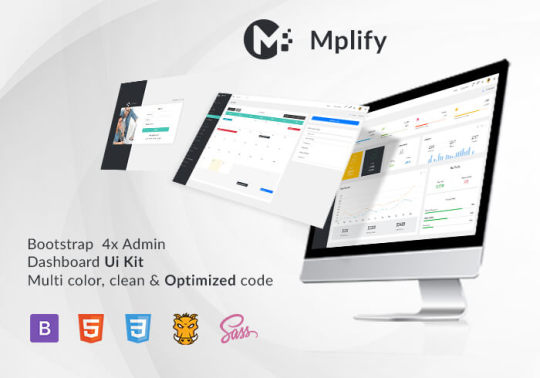
Key Features
Bootstrap 4.3.1: Ensures compatibility and modern design standards.
jQuery 3.3.1: Offers extensive plugins and support.
Built-in SCSS: Provides more flexibility and control over styles.
Light & Dark Full Support: Allows users to switch between light and dark themes.
RTL Full Support: Right-to-left language support for global accessibility.
W3C Validate Code: Ensures high coding standards and practices.
Mobile and Tablet Friendly: Responsive design for all devices.
Treeview: For hierarchical data display.
Drag & Drop Upload: Simplifies file uploading processes.
Image Cropping: Integrated tools for editing images.
Summernote: Rich text editor integration.
Markdown: Support for markdown formatting.
Beautiful Inbox Interface: User-friendly email management.
User-Friendly Chat App: Built-in chat application.
Scrum & Kanban Taskboard: Task management tools.
Add Events to Your Calendar: Event management capabilities.
File Manager: Efficient file organization and management.
Blogging: Tools to manage and create blog posts.
Testimonials: Features to showcase user testimonials.
Maintenance: Tools to manage and schedule maintenance.
Team Board: Collaboration tools for team management.
Search Result: Enhanced search functionalities.
Beautiful Pricing: Elegant pricing tables and plans.
Contact List & Grid: Efficient contact management.
User Profile: Customizable user profiles.
Extended Forms: Advanced form functionalities.
Clean Widgets: A variety of clean, modern widgets.
Technical Specifications
Bootstrap 4.3.1
Bootstrap 4.3.1 is a powerful front-end framework for faster and easier web development. It includes HTML and CSS-based design templates for typography, forms, buttons, tables, navigation, modals, image carousels, and many other interface components, as well as optional JavaScript plugins. Mplify leverages Bootstrap 4.3.1 to ensure a consistent and responsive design across all devices.
jQuery 3.3.1
jQuery is a fast, small, and feature-rich JavaScript library. It makes things like HTML document traversal and manipulation, event handling, and animation much simpler with an easy-to-use custom API integration that works across a multitude of browsers. Mplify includes jQuery 3.3.1 to provide enhanced functionality and interactivity to your applications.
Built-in SCSS
SCSS is a preprocessor scripting language that is interpreted or compiled into CSS. It allows you to use variables, nested rules, mixins, inline imports, and more, all with a fully CSS-compatible syntax. With SCSS, Mplify offers a more powerful and flexible way to manage styles.
Light & Dark Full Support
Mplify comes with built-in support for light and dark themes, allowing users to switch between these modes based on their preferences. This feature enhances user experience and accessibility, especially in different lighting conditions.
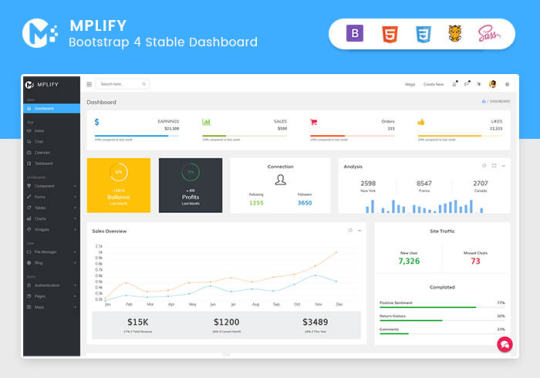
RTL Full Support
For developers targeting global audiences, Mplify provides full right-to-left (RTL) language support. This feature ensures that languages like Arabic, Hebrew, and Persian are properly displayed, making the template versatile and inclusive.
W3C Validate Code
The World Wide Web Consortium (W3C) sets the standards for web development. Mplify adheres to W3C's coding standards, ensuring that the template is built with clean, valid code, which improves browser compatibility, SEO, and overall performance.
Mobile and Tablet Friendly
In today's mobile-first world, having a responsive design is crucial. Mplify is designed to be fully responsive, ensuring that your mobile application looks great and functions seamlessly on all devices, including desktops, tablets, and smartphones.
Applications
Mplify’s versatile design and feature set make it suitable for a wide range of applications across various industries. Here are some key applications:
Admin Dashboards
Mplify provides a robust framework for building admin dashboards. With its extensive set of UI components, charts, forms, and tables, you can create comprehensive dashboards that provide valuable insights and data visualization.
CMS (Content Management Systems)
With features like blogging, file management, and user profile management, Mplify can be used to build powerful CMS platforms. Its clean widgets and beautiful interface ensure that the content management experience is both efficient and enjoyable.
CRM (Customer Relationship Management)
Mplify’s built-in tools for managing contacts, scheduling events, and maintaining communication through a chat app make it an excellent choice for developing CRM systems. These features help businesses manage customer interactions and data effectively.
Business Websites
The multi-purpose nature of Mplify allows it to be used for various business websites. Whether you need a portfolio, a blog, or a corporate website, Mplify provides the necessary tools and components to create a professional online presence.
Blogging Platforms
With integrated tools like Summernote for rich text editing and Markdown support, Mplify is ideal for creating blogging platforms. The beautiful inbox interface and testimonial features enhance the blogging experience, making it easy to manage and publish content.
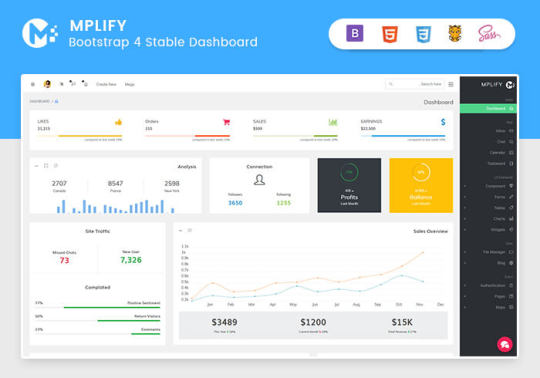
Benefits
Easy and Fast Development
Mplify is designed to streamline the development process. With its pre-built components and templates, you can quickly assemble functional and aesthetically pleasing applications. This reduces development time and costs, allowing you to focus on implementing your ideas in real time.
Professional and Modern Design
Mplify offers a clean, modern design that is both professional and user-friendly. The template includes a variety of customizable widgets and components that adhere to the latest design standards, ensuring your application looks polished and up-to-date.
Comprehensive Feature Set
From task management tools like Scrum and Kanban boards to extensive form functionalities, Mplify provides a wide range of features that cater to various needs. This comprehensive feature set makes it a versatile solution for different types of projects.
Responsive and Mobile-Friendly
With Mplify, you can ensure that your application is accessible on all devices. Its responsive design adapts to different screen sizes, providing a seamless user experience on desktops, tablets, and smartphones.
Global Accessibility
Mplify’s RTL support and multi-language capabilities make it suitable for global applications. This feature ensures that your application can cater to users from different regions, enhancing its reach and usability.
Regular Updates and Support
When you purchase a license for Mplify, you receive all future updates for free. This ensures that your application remains up-to-date with the latest features and improvements. Additionally, Mplify provides excellent customer support to assist with any issues or queries.
Challenges and Limitations
Learning Curve
While Mplify is designed to be user-friendly, there may be a learning curve for beginners who are not familiar with Bootstrap or jQuery. However, comprehensive documentation and community support can help mitigate this challenge.
Customization
Although Mplify offers a wide range of customization options, extensive customization may require advanced knowledge of SCSS and JavaScript. This could be a limitation for developers who are not well-versed in these technologies.
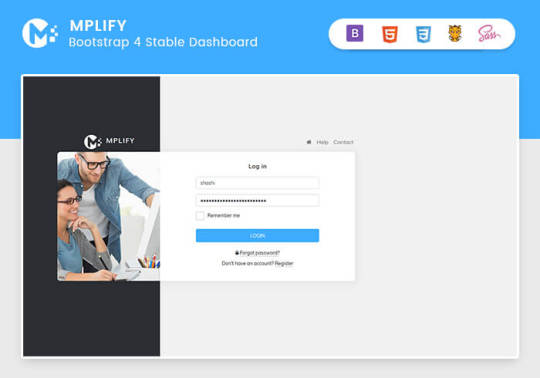
Performance
As with any feature-rich template, there is a potential for performance issues if too many components and plugins are used simultaneously. It is important to optimize the application and selectively use features to maintain optimal performance.
Latest Innovations
Enhanced UI Components
Mplify continues to evolve with regular updates that introduce new and improved UI components. These enhancements ensure that your application remains modern and functional.
Advanced-Data Visualization
Recent updates have focused on improving data visualization capabilities. With enhanced charting tools and interactive elements, Mplify allows for more dynamic and engaging data presentation.
Integration with New Technologies
Mplify is continuously updated to integrate with the latest web technologies. This ensures compatibility with new frameworks and libraries, providing developers with more tools to build advanced applications.
Future Prospects
AI and Machine Learning Integration
The future of Mplify may include integration with AI and machine learning tools. This would enable developers to build more intelligent and automated applications, enhancing user experience and functionality.
Expanded Plugin Support
As the web development landscape evolves, Mplify is likely to expand its plugin support. This will provide developers with more options for extending the functionality of their applications.
Improved Accessibility Features
Mplify is expected to continue enhancing its accessibility features. This includes better support for assistive technologies and compliance with accessibility standards, ensuring that applications built with Mplify are inclusive for all users.
Comparative Analysis
Versus Other Bootstrap Templates
When compared to other Bootstrap templates, Mplify stands out due to its comprehensive feature set, modern design, and extensive customization options. While other templates may offer similar components, Mplify's unique features like RTL support and advanced task management tools give it an edge.
Versus Custom Development
Opting for a pre-built template like Mplify can significantly reduce development time and costs compared to custom web development. While custom development offers more flexibility, Mplify provides a robust foundation that can be easily customized to meet specific needs.
User Guides and Tutorials
Getting Started with Mplify
Installation: Download and install Mplify from the official website or marketplace.
Configuration: Configure the template settings according to your project requirements.
Customization: Use the built-in SCSS files to customize the styles and appearance.
Integration: Integrate Mplify with your backend systems and databases.
Deployment: Deploy your application on your preferred hosting platform.
Advanced Customization Techniques
SCSS Variables: Use SCSS variables to easily change colors, fonts, and other styles.
JavaScript Customization: Extend the functionality by adding custom JavaScript code.
Component Modification: Modify existing components or create new ones to meet specific needs.
Performance Optimization: Optimize the performance by minifying CSS and JavaScript files, and selectively loading components.
Conclusion
Mplify is a powerful, versatile, and user-friendly Bootstrap 4 admin dashboard template. It offers a wide range of features and customization options, making it suitable for various applications, from admin dashboards to business websites. With its modern design, responsive layout, and extensive documentation, Mplify simplifies the development process, allowing developers to implement their ideas in real time efficiently.
Whether you are building a CMS, CRM, or a personal blog, Mplify provides the tools and flexibility needed to create a professional and functional web application. Its ongoing updates and support ensure that your projects remain current and compatible with the latest web technologies.
#Mplify Admin#Bootstrap 4.3.1#jQuery 3.3.1#SCSS#Light & Dark Theme#RTL Support#W3C Validation#Responsive Design#Admin Template#Admin Dashboard#CMS#CRM#Blogging#Business Websites#Web Development#UI Components#Data Visualization#AI Integration#Machine Learning#Accessibility Features#Task Management#File Management#Rich Text Editor#Markdown Support#User Profiles#Performance Optimization#Web Technologies#Custom Development#Web Application Development#Front-end Framework
0 notes
Text
Using Django as a Powerful Full-Stack Framework for Python Developers In Achieversit
Python, known for its simplicity and versatility, is a popular choice among developers for building web applications. When it comes to full-stack web development, Django, a high-level Python web framework, stands out as a powerful tool. In this article, we'll explore the capabilities of Django and how it empowers Python developers to build robust, feature-rich, and scalable full-stack applications.
What is Django?
Django is a high-level, open-source web framework for Python that encourages rapid development and clean, pragmatic design. It follows the "batteries-included" philosophy, which means it provides a wide range of built-in features and libraries to streamline web development. Here's why Django is a great choice for full-stack Python development:
1. Built-in Features
Django comes with a plethora of built-in features and modules, including:
Admin Interface: Django's admin interface is a powerful tool that automatically generates an admin panel for your application, allowing you to manage data without writing custom admin panels.
Authentication and Authorization: Django offers a robust authentication system with user management and customizable permissions, making it easy to secure your application.
Database Abstraction: Django supports multiple database backends, allowing you to work with databases like PostgreSQL, MySQL, SQLite, and more.
URL Routing: Django's URL routing system enables you to define clean and human-readable URLs.
Form Handling: Easily create and process HTML forms using Django's form handling features.
Template Engine: Django includes a template system for generating dynamic HTML, making it easy to separate the presentation layer from the application's logic.
2. Extensibility
While Django provides a lot out of the box, it also allows developers to extend and customize their applications. You can create custom templates, add middleware, develop custom authentication backends, and integrate third-party packages as needed.
3. Security
Django is designed with security in mind. It includes protection against common web vulnerabilities like cross-site scripting (XSS), cross-site request forgery (CSRF), and more. Django's ORM also helps prevent SQL injection.
4. Scalability
Django is well-suited for building scalable applications. Its modular design and support for distributed architectures make it a great choice for handling increased workloads.
5. Community and Documentation
Django has a vibrant and supportive community, which means there are plenty of resources, packages, and tutorials available. The comprehensive official documentation makes it easy to get started.
Django for Full-Stack Development
When using Django for full-stack development, here's how you can harness its power:
Backend Development: Django provides a strong foundation for your back-end, including database management, authentication, and API development.
Front-End Integration: You can integrate Django with popular front-end frameworks like React or Vue.js to build dynamic and responsive user interfaces.
RESTful APIs: Django REST framework, a popular extension for Django, simplifies the creation of RESTful APIs, making it easy to build web services.
Real-Time Features: Integrate real-time features using Django Channels to build chat applications, live notifications, or other interactive features.
Conclusion
Django is an excellent choice for full-stack Python development, offering a comprehensive toolkit for building web applications. Whether you're working on a personal project, a startup, or an enterprise-level application, Django's features, extensibility, and security make it a powerful framework for Python developers. AchieversIT is committed to equipping developers with the skills to excel in Django and other cutting-edge technologies.
Stay connected with AchieversIT for more insightful articles and tutorials to enhance your full-stack development skills.
ReadMore:
0 notes
Text
Admin Dashboard HTML Template with Dashboard UI Kit – Dark Power BI
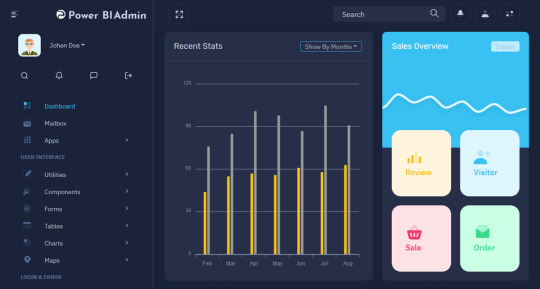
Dark Power BI Template is a fully responsive Admin Dashboard HTML Template built with Bootstrap 4 stable Framework, modern web technology HTML5 and CSS3. Lightweight and easy customizable which is basically designed for the developers who want to customize it.

Read More Admin Dashboard HTML Template with Dashboard UI Kit – Dark Power BI
Like Us




#Microsoft Power BI#Reports Power BI#Power BI#Power BI Template#hims dashboard#Admin Dashboard HTML Template#Dashboard Template#Bootstrap Admin Panel#Admin Panel#Bootstrap Web Application Template#Bootstrap 4 Templates#Premium Admin Panel#Html5 Admin Template#Bootstrap Form Template#Backend Html Admin Template#Bootstrap Panel Template#Modern Admin Template#Web App Best Modern Bootstrap Dashboard#Web App Application Dashboard Template#Admin Panel Template Bootstrap 4#Admin Panel Dashboard#Bootstrap Admin Dashboard Template#Admin Dashboard#Saas Dashboard#Bootstrap Admin Grid Template#Dashboard Design#Admin Dashboard Template#Dashboard Ui Kit#CSS Admin Template
0 notes
Text
Midone - HTML Admin Dashboard Template
Midone – HTML Admin Dashboard Template
HTML Admin Dashboard Template Midone is a responsive and fully featured Admin Template powered by the utility-first CSS framework TailwindCSS 3+. If you’re a developer looking for an admin dashboard with ready-made Tailwind components, developer-friendly, and highly customizable Midone is one of the best on the market. Even if you are not familiar with the framework, the template’s UI components…

View On WordPress
0 notes
Text
Codebase - Bootstrap 4 Admin Dashboard Template & Laravel 6 Starter Kit - Laravel
Codebase – Bootstrap 4 Admin Dashboard Template & Laravel 6 Starter Kit – Laravel
Codebase – Bootstrap 4 Admin Dashboard Template & Laravel 6 Starter Kit – Laravel LIVE PREVIEWBUY FOR $28 Demo Download Details
[ad_1]







Codebaseis a super flexible UI framework built with Bootstrap 4, ECMAScript 6 (ES6) and Sass that will enable you to build all kind of pages using the same fast and powerful layout. It comes packed with 3 different versions, Get Started, HTML and PHP to help you…
View On WordPress
#admin#admin dashboard#admin template#backend#bootstrap#Clean#Codebase#dashboard#gulp#html template#jquery#Kit#laravel#responsive#sass#Starter#Template#web app#website
0 notes
Text
JAMstack, Headless CMS vs Traditional CMS
This article will cover the basics of what a headless CMS actually is. You will learn about the main differences between a headless CMS (eg. Storyblok, Contentful, Prismic, …) - and more traditional CMS like Adobe Experience Manager, Wordpress, and Sitecore.
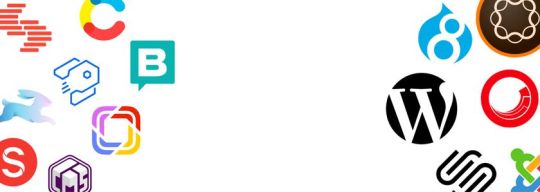
What is a headless CMS?
A headless CMS is a back-end only content management system (CMS) built from the ground up as a content repository that makes content accessible via a RESTful API for display on any device.
The term “headless” comes from the concept of chopping the “head” (the front end, i.e. the website) off the “body” (the back end, i.e. the content repository). A headless CMS remains with an interface to add content and a RESTful API (JSON, XML) to deliver content wherever you need it. Due to this approach, a headless CMS does not care about how and where your content gets displayed. A headless CMS has only one focus: storing and delivering structured content.
The counterpart of a headless CMS is often called monolithic, regular or coupled CMS and we’re going to use those terms later on.

Let’s have a look at WordPress and their feature set:
A database for the content to read and write to.
An admin interface to let editors manage the content.
An integration of reading and writing.
The actual front-end that combines the data from the database with HTML.
To convert that into a headless CMS we simply remove the feature four from the stack. The head of that CMS - the actual website - was simply chopped off. What still stays is an application that allows content management (Admin UI) and reading (API: combined Integrations). Voila you now have got yourself a headless CMS.

Other than by using a regular/monolithic CMS, one website can’t be built only with a headless CMS. A headless CMS separated the head from its stack and therefore lacks this point by design. Therefore, the developer must craft the website by his- or herself and use the Content Delivery API of the headless CMS to load the content.
Creating the whole website on their own seems like a big task on the list, but by decoupling the CMS from the front-end a developer can choose any technology they are already familiar with and do not need to learn the technology for that specific CMS. Another big bonus is the fact that one developer can also focus on their own work without handling the bugs of an already existing stack of technology - therefore it is easier to optimize pages for googles pagespeed and even relaunch parts of the website without needing to care about the content.
Do I need a headless CMS?
The answer to this question is quite simple, but it won’t help you much: It depends on your requirements. There are use cases where one CMS outstands the other and vice versa. To help you decide, let’s have a look at the benefits really quick:
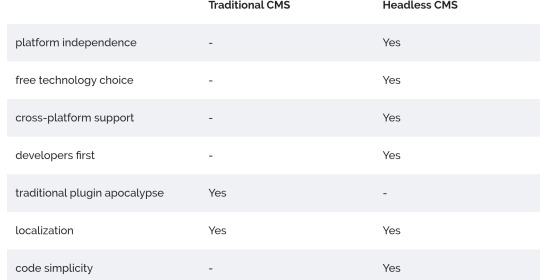
Use cases for Headless CMS
Build a website with a technology you are familiar with.
Websites, Web apps that use JavaScript frameworks (VueJs, React, Angular)
Websites created with static site generators (Jekyll, Middleman, …)
Native Mobile Apps (iOS, Android, Windows Phone)
Enrich product information on ecommerce sites.
Point is: It is not limited to websites
A headless CMS can deliver your content through an API directly to where you need it. Because of the headless approach the content can be used on an iOS app, Android app as well as any platform and technology you can think of (yes and even a Windows Phone App) and is therefore a powerful option for mobile and web developers.
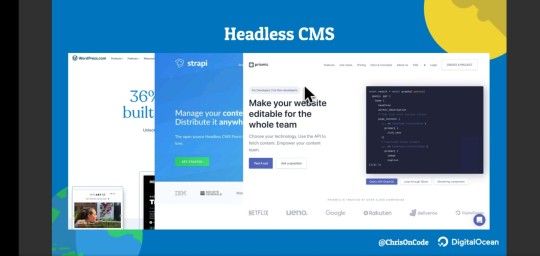
Many believes JAMstack, PROGRESSIVE WEB APPS, Static Site Generators and Headless CMS are the future!
During the start of the age of the internet, static site were prevalent. You had to know how to write HTML to be called a Web Developer. Back then WordPress didn’t exist. All you had was HTML, CSS and JavaScript, eventually WordPress came and promised a clean interface, no coding skills need and a whole lot of themes/templates which you could edit by yourself through their interface. Since then wordpress has pretty much become an internet ruler along side Google. But now the tide is shifting, will you shift as well.
What is a JAMstack
You can also use JAMstack with headless CMS. The JAMstack allows people to create websites that are simpler, faster, and more secure than other web development methods. Sites created with the JAMstack are delivered by pre-rendering files that are served directly from a CDN, removing the requirement to manage or run web servers.
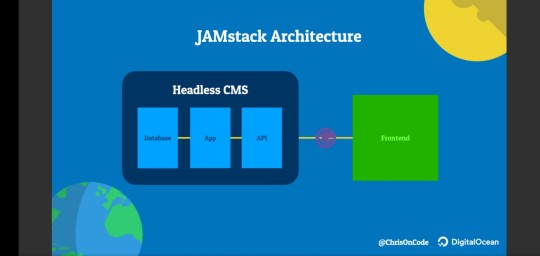
You may have already seen or worked on a JAMstack site! They do not have to include all attributes of JavaScript, APIs, and Markup. They might be built using by hand, or with Jekyll, Hugo, Nuxt, Next, Gatsby, or another static site generator…
The thing that they all have in common is that they don’t depend on a web server.
JAVASCRIPT
Any dynamic programming during the request/response cycle is handled by JavaScript, running entirely on the client. This could be any front end framework, library, or even vanilla JavaScript. eg Jekyll, Gatsby, Nuxtjs, Nextjs, Hugo, Hexo, Vuejs.
API
All server-side processes or database actions are abstracted into reusable APIs, accessed over HTTPS with JavaScript. These can be custom-built or leverage third-party services. eg GitHub API PI, Vero API, Google sheets API, YouTube API.
MARKUP
Templated markup should be pre-built at deploy time, usually using a site generator for content sites, or a build tool for web apps.
When is your site not built with the JAMstack?
Any project that relies on a tight coupling between client and server is not built with the JAMstack. This would include:
A single page app that uses isomorphic rendering to build views on the server at run time.
A monolithic server-run web app that relies on Ruby, Node, or another backend language.
A site built with a server-side CMS like WordPress, Drupal, Joomla, or Squarespace.
Why choose JAMstack?
Better performance – Why wait for pages to build on the fly when you can generate them at deploy time? When it comes to minimizing the time to first byte, nothing beats pre-built files served over a CDN.
Higher Security – With server-side processes abstracted into microservice APIs, surface areas for attacks are reduced. You can also leverage the domain expertise of specialist third-party services. And also with server side CMS you get a larger surface area prone to attack.
Affordable, Easier Scaling – When your deployment amounts to a stack of files that can be served anywhere, scaling is a matter of serving those files in more places. CDNs are perfect for this, and often include scaling in all of their plans.
Better Developer Experience – Loose coupling and separation of controls allow for more targeted development and debugging, and the expanding selection of CMS options for site generators remove the need to maintain a separate stack for content and marketing.
#references : StoryBlok https://www.storyblok.com/tp/headless-cms-explained?_ampify=1&__twitter_impression=true
1 note
·
View note
Text
Ample Admin - Ultimate Dashboard Template
Ample Admin – Ultimate Dashboard Template
LIVE PREVIEWBUY FOR $59 Ample Admin is a popular open source WebApp template for admin dashboards and control panels. It is a responsive HTML template that is based on the CSS framework Bootstrap 5. It utilizes all of the Bootstrap components in its design and re-styles many commonly used plugins to create a consistent design that can be used as a user interface for backend applications. Ample…

View On WordPress
0 notes